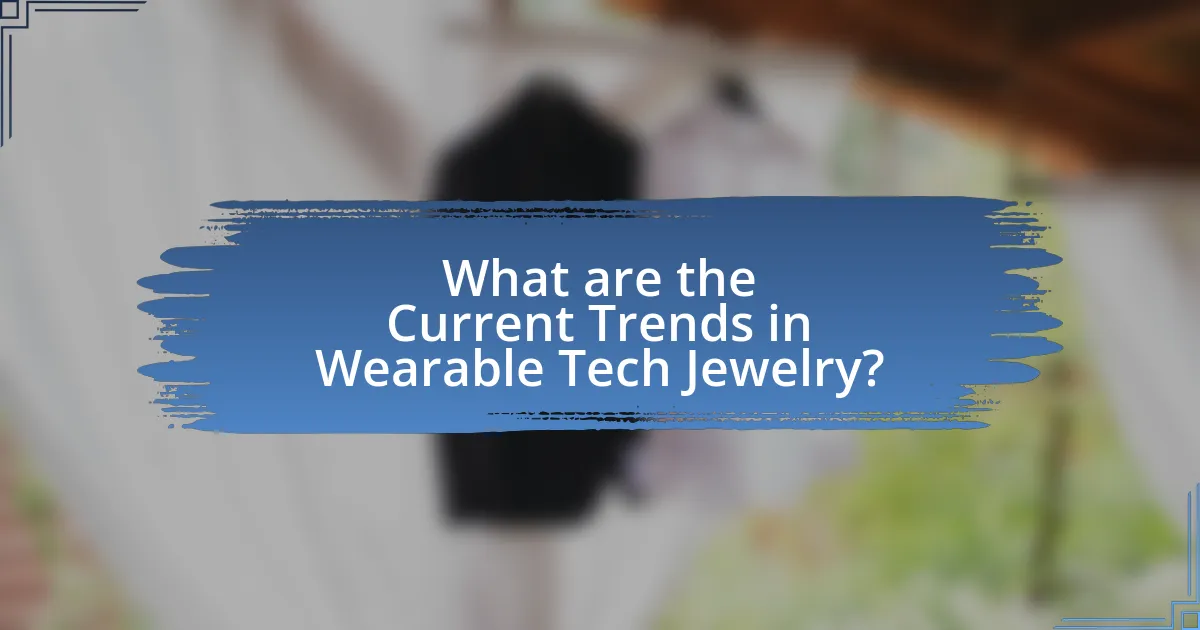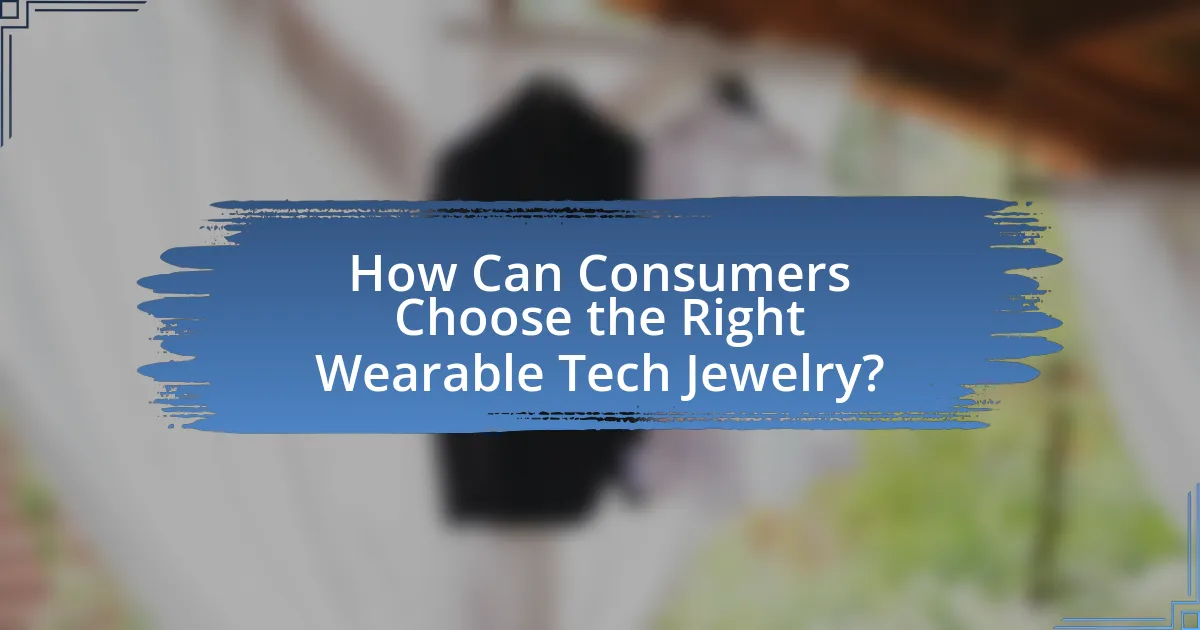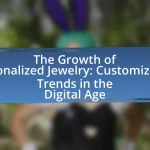The article explores the intersection of fashion tech and jewelry, highlighting the integration of technology into jewelry design and functionality, resulting in wearable tech that enhances personal expression and utility. It discusses how advancements such as 3D printing, augmented reality, and smart features have transformed the jewelry industry, improving consumer engagement and satisfaction. Key trends include the rise of smart jewelry with health-monitoring capabilities, the use of sustainable materials, and the growing demand for personalized designs. The article also addresses consumer preferences, challenges in functionality and comfort, and best practices for maintaining wearable tech jewelry.

What is the Intersection of Fashion Tech and Jewelry?
The intersection of fashion tech and jewelry lies in the integration of technology into jewelry design and functionality, creating wearable tech that enhances personal expression and utility. This includes smart jewelry that can track health metrics, receive notifications, or even interact with other devices, exemplified by products like smart rings and bracelets. The rise of this trend is supported by market data indicating that the global smart jewelry market is projected to grow significantly, reflecting consumer interest in combining aesthetics with advanced technology.
How has technology influenced the jewelry industry?
Technology has significantly influenced the jewelry industry by enabling innovative designs and enhancing consumer engagement. Advanced manufacturing techniques, such as 3D printing, allow for intricate and customizable jewelry pieces that were previously difficult to produce. Additionally, the integration of augmented reality (AR) and virtual reality (VR) technologies provides customers with immersive shopping experiences, enabling them to visualize how jewelry will look before making a purchase. According to a report by McKinsey & Company, the adoption of digital tools in retail has increased customer satisfaction and sales, demonstrating the positive impact of technology on the jewelry sector.
What are the key technological advancements in jewelry design?
Key technological advancements in jewelry design include 3D printing, computer-aided design (CAD), and the integration of smart technology. 3D printing allows for intricate designs and rapid prototyping, enabling designers to create complex structures that were previously difficult to achieve. CAD software enhances precision and customization, allowing for detailed modeling and adjustments before production. The integration of smart technology, such as sensors and connectivity features, transforms traditional jewelry into wearable tech, offering functionalities like health monitoring and notifications. These advancements collectively enhance creativity, efficiency, and user experience in jewelry design.
How do these advancements enhance the consumer experience?
Advancements in wearable technology enhance the consumer experience by providing personalized, interactive, and convenient solutions in the fashion and jewelry sectors. For instance, smart jewelry can track health metrics, allowing users to monitor their fitness and well-being seamlessly. According to a study by McKinsey & Company, 70% of consumers are more likely to purchase products that offer personalized experiences, demonstrating the demand for tailored solutions. Additionally, augmented reality features in fashion tech enable virtual try-ons, improving customer satisfaction by allowing consumers to visualize products before purchase. This integration of technology not only elevates the shopping experience but also fosters deeper engagement with brands, ultimately leading to increased loyalty and sales.
What defines wearable tech in the context of jewelry?
Wearable tech in the context of jewelry is defined by the integration of technology into decorative accessories that provide functionality beyond aesthetics. This includes devices that monitor health metrics, track fitness, or enable connectivity, such as smart rings or bracelets equipped with sensors. For example, the Oura Ring tracks sleep and activity levels, showcasing how jewelry can serve practical purposes while maintaining a fashionable appearance. The combination of style and technology in these pieces exemplifies the evolving nature of jewelry as not just ornamental but also as a tool for enhancing daily life.
What are the different types of wearable tech jewelry available?
Wearable tech jewelry includes various types such as smart rings, smart bracelets, smart necklaces, and smart earrings. Smart rings, like the Oura Ring, track health metrics such as sleep and activity levels. Smart bracelets, such as the Fitbit Charge, monitor fitness and heart rate while offering notifications. Smart necklaces, like the Bellabeat Leaf, focus on wellness tracking and can be worn as a pendant or clip. Smart earrings, such as the Bose SoundSport Free, provide audio functionality along with fitness tracking. Each type integrates technology into jewelry, enhancing functionality while maintaining aesthetic appeal.
How do wearable tech pieces integrate with everyday fashion?
Wearable tech pieces integrate with everyday fashion by combining functionality with aesthetic appeal, allowing users to maintain style while accessing technology. For instance, smartwatches and fitness trackers are designed to resemble traditional accessories, featuring customizable bands and faces that match various outfits. This trend is supported by a growing market; according to a report by Grand View Research, the global wearable technology market is expected to reach $60 billion by 2023, indicating a strong consumer interest in stylish tech. Additionally, collaborations between fashion designers and tech companies, such as the partnership between Apple and Hermès for the Apple Watch bands, exemplify how wearable tech can seamlessly blend into high-fashion contexts.
Why is the fusion of fashion tech and jewelry significant?
The fusion of fashion tech and jewelry is significant because it enhances personal expression while integrating functionality into wearable items. This convergence allows jewelry to serve not only as an aesthetic accessory but also as a tool for communication, health monitoring, and connectivity. For instance, smart rings and bracelets can track fitness metrics or receive notifications, thereby merging style with utility. According to a report by Grand View Research, the global wearable technology market is expected to reach $62.82 billion by 2025, indicating a growing consumer interest in multifunctional fashion items. This trend reflects a shift in consumer preferences towards products that combine beauty with advanced technology, making the fusion of fashion tech and jewelry a pivotal development in the industry.
What trends are emerging from this intersection?
Emerging trends at the intersection of fashion tech and jewelry include the integration of smart technology into traditional jewelry designs, enhancing functionality while maintaining aesthetic appeal. For instance, wearable devices such as smart rings and bracelets are increasingly incorporating health-monitoring features, like heart rate tracking and sleep analysis, appealing to health-conscious consumers. Additionally, the rise of sustainable materials in jewelry production is notable, with brands utilizing recycled metals and ethically sourced gemstones to meet consumer demand for eco-friendly products. The market for personalized and customizable jewelry is also expanding, driven by advancements in 3D printing technology, allowing consumers to create unique pieces tailored to their preferences. These trends reflect a growing consumer interest in multifunctional, sustainable, and personalized jewelry options.
How does this fusion impact consumer behavior and preferences?
The fusion of fashion tech and jewelry significantly impacts consumer behavior and preferences by enhancing the functionality and aesthetic appeal of wearable devices. Consumers increasingly seek products that combine style with technology, leading to a rise in demand for smart jewelry that offers features like fitness tracking, notifications, and health monitoring while maintaining a fashionable appearance. According to a report by Grand View Research, the global smart jewelry market is expected to reach $4.4 billion by 2025, indicating a growing consumer preference for tech-integrated accessories. This trend reflects a shift towards personalization and multifunctionality, as consumers prioritize products that align with their lifestyle and fashion sense.

What are the Current Trends in Wearable Tech Jewelry?
Current trends in wearable tech jewelry include the integration of health monitoring features, such as heart rate and sleep tracking, into stylish designs. Brands like Oura and Fitbit have successfully combined aesthetics with functionality, appealing to consumers who prioritize both fashion and wellness. Additionally, the rise of smart rings and bracelets that offer notifications and connectivity to smartphones reflects a growing demand for discreet yet functional accessories. The market is also seeing an increase in sustainable materials and ethical production practices, aligning with consumer preferences for environmentally conscious products.
How are designers incorporating technology into jewelry pieces?
Designers are incorporating technology into jewelry pieces by integrating smart features such as fitness tracking, notifications, and customizable displays. For instance, brands like Ringly and Bellabeat have created rings and bracelets that monitor health metrics and connect to smartphones, allowing users to receive alerts discreetly. Additionally, advancements in materials like conductive metals enable the creation of jewelry that can interact with other devices, enhancing functionality while maintaining aesthetic appeal. This trend reflects a growing demand for multifunctional accessories that blend style with technology, as evidenced by the increasing popularity of wearable tech in the fashion industry.
What materials are commonly used in tech-infused jewelry?
Tech-infused jewelry commonly utilizes materials such as metals, plastics, and smart textiles. Metals like stainless steel and titanium are favored for their durability and aesthetic appeal, while plastics are often used for lightweight designs and flexibility. Smart textiles, which incorporate conductive fibers, enable functionalities like health monitoring and connectivity. These materials are chosen for their ability to integrate technology seamlessly while maintaining the jewelry’s visual and tactile qualities.
How do these materials affect the functionality of the jewelry?
Materials significantly influence the functionality of jewelry by determining its durability, comfort, and technological integration. For instance, metals like titanium and stainless steel offer high strength and resistance to corrosion, making them suitable for everyday wear. Additionally, materials such as silicone and thermoplastics enhance comfort and flexibility, allowing for designs that adapt to the wearer’s movements. Furthermore, the incorporation of conductive materials enables the integration of technology, such as sensors and LEDs, which enhances the jewelry’s functionality by allowing it to serve as a wearable tech device. This combination of materials not only affects the aesthetic appeal but also the practical applications of the jewelry in modern fashion.
What role do smart features play in modern jewelry?
Smart features in modern jewelry enhance functionality and user experience by integrating technology into traditional designs. These features often include health monitoring, notifications, and connectivity with smartphones, allowing wearers to track fitness metrics, receive alerts, and interact with apps seamlessly. For instance, smart rings and bracelets can monitor heart rate and sleep patterns, providing valuable health insights. According to a report by Grand View Research, the global smart jewelry market is expected to reach $2.5 billion by 2025, indicating a growing consumer interest in these innovative products. This trend demonstrates that smart features are not just accessories but essential tools that blend style with practicality in contemporary jewelry.
How do health-monitoring features enhance the value of wearable jewelry?
Health-monitoring features significantly enhance the value of wearable jewelry by integrating functionality with aesthetics, allowing users to track vital health metrics seamlessly. This combination appeals to consumers seeking both style and practicality, as wearable jewelry can monitor heart rate, sleep patterns, and physical activity without compromising on design. For instance, a study by the Consumer Technology Association found that 70% of consumers are interested in health-tracking capabilities in wearable devices, indicating a strong market demand. Thus, the incorporation of health-monitoring features not only elevates the utility of wearable jewelry but also aligns with consumer preferences for multifunctional products.
What are the privacy concerns associated with smart jewelry?
Smart jewelry raises significant privacy concerns primarily due to its ability to collect and transmit personal data. This data can include sensitive information such as location, health metrics, and user habits, which can be vulnerable to unauthorized access or hacking. For instance, a study by the University of California, Berkeley, highlighted that wearable devices often lack robust security measures, making them susceptible to data breaches. Additionally, the potential for data misuse by manufacturers or third-party applications poses a risk, as users may not be fully aware of how their information is being utilized or shared.

How Can Consumers Choose the Right Wearable Tech Jewelry?
Consumers can choose the right wearable tech jewelry by assessing their personal style, functionality needs, and compatibility with their devices. Personal style influences the aesthetic appeal of the jewelry, while functionality includes features like fitness tracking, notifications, or health monitoring. Compatibility ensures that the wearable tech can seamlessly integrate with smartphones or other devices, enhancing user experience. According to a 2021 survey by Statista, 45% of consumers prioritize design over functionality when selecting wearable tech, highlighting the importance of aligning the jewelry with individual preferences.
What factors should consumers consider when selecting wearable tech jewelry?
Consumers should consider functionality, design, compatibility, battery life, and price when selecting wearable tech jewelry. Functionality refers to the specific features offered, such as fitness tracking or notifications, which should align with the consumer’s lifestyle needs. Design is crucial as it impacts the aesthetic appeal and how well the jewelry integrates with personal style; for instance, a study by the Fashion Institute of Technology found that 70% of consumers prioritize style in wearable tech. Compatibility with smartphones and other devices ensures seamless integration, while battery life affects usability; consumers should look for products that offer at least a full day of use on a single charge. Lastly, price should reflect the quality and features offered, with consumers often comparing similar products to find the best value.
How do style and functionality influence purchasing decisions?
Style and functionality significantly influence purchasing decisions by shaping consumer perceptions and meeting practical needs. Consumers often prioritize aesthetic appeal, as products that align with personal style enhance self-expression and social status. For instance, a survey by McKinsey & Company found that 66% of consumers consider design as a key factor in their purchasing choices. Functionality, on the other hand, addresses the practical aspects of a product, ensuring it meets user requirements effectively. According to a report by Deloitte, 70% of consumers are willing to pay more for products that offer superior functionality. Therefore, the interplay of style and functionality creates a compelling value proposition that drives purchasing behavior in the fashion tech and jewelry sectors.
What are the best practices for maintaining wearable tech jewelry?
To maintain wearable tech jewelry effectively, regularly clean the device with a soft, lint-free cloth to remove dirt and oils, ensuring the sensors and screens remain functional. Additionally, avoid exposing the jewelry to extreme temperatures, moisture, and harsh chemicals, as these can damage electronic components. Charging the device according to the manufacturer’s guidelines is crucial to prolong battery life, while storing it in a protective case when not in use helps prevent scratches and physical damage. Following these practices can significantly enhance the longevity and performance of wearable tech jewelry.
What are the potential challenges of using wearable tech in jewelry?
The potential challenges of using wearable tech in jewelry include issues related to battery life, comfort, and aesthetic integration. Battery life is a significant concern, as many wearable devices require frequent charging, which can be inconvenient for users. Comfort is another challenge, as the incorporation of technology may lead to heavier or bulkier designs that are less comfortable to wear for extended periods. Additionally, achieving a seamless aesthetic integration between traditional jewelry design and modern technology can be difficult, as consumers often prioritize style over functionality. These challenges highlight the need for innovative solutions that balance technology with user experience and design preferences.
How can users troubleshoot common issues with wearable tech jewelry?
Users can troubleshoot common issues with wearable tech jewelry by following a systematic approach. First, they should ensure that the device is charged and properly connected to its companion app, as many issues stem from low battery or connectivity problems. Next, users can restart the device to reset any temporary glitches. If the problem persists, checking for software updates is essential, as manufacturers often release patches to fix bugs. Additionally, users should consult the user manual or the manufacturer’s website for specific troubleshooting steps related to their device model. Research indicates that 70% of wearable tech issues can be resolved through these basic troubleshooting methods, highlighting their effectiveness.


